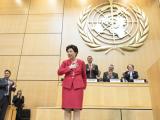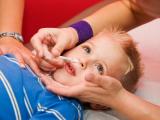Nov 3, 2009 (CIDRAP News) – A study of California's most severely ill patients during the first 16 weeks of the novel H1N1 pandemic is in line with other recent studies that have shown two unique features of the virus—that it hits young people hard and that obesity appears to be a risk factor.
The authors from the California Pandemic (H1N1) Working Group compiled their report on the basis of enhanced surveillance by the California Department of Public Health and 61 local health departments between Apr 23 and Aug 11. Their findings appear today in the Journal of the American Medical Association (JAMA).
During that period, California had reports of 1,088 cases of hospitalization or death from pandemic H1N1 flu. The median age was 27, which is similar to the median in other recent studies of severe patients from the US Centers for Disease Control and Prevention (CDC), Mexico, Canada's Manitoba province, Australia, and New Zealand.
Infectious disease experts have pointed out several times that the pandemic virus's predilection for younger patients sets it apart from seasonal influenza, in which the severest cases are seen in children under age 5 and adults over age 65. For example, in the CDC's recent study the median age of severely ill patients was 21, and in the Canadian and Mexican studies the median ages were 32 and 44, respectively.
The report from California says that 68% of severely ill pandemic H1N1 flu patients had underlying medical conditions that put them at higher risk. For comparison, 81% of the patients in the CDC study had an underlying condition, as did 51% of those in the Canadian study.
Obesity as risk factor
Over the summer, obesity emerged as a possible risk factor for serious pandemic flu illness, a pattern not seen with seasonal flu. Public health officials aren't sure why, but some have said that obese patients tend to have other underlying conditions and that carrying extra weight may contribute to breathing compromise.
In the California survey, of adults for whom body mass index (BMI) data were available, more than half were obese and about one fourth were morbidly obese. The authors wrote that about 4% of adults in the United States morbidly obese.
The most common causes of death in the California patients were viral pneumonia and acute respiratory distress syndrome. Only 4% of patients had secondary bacterial infections—a finding similar to other recent studies and one that also seems to distinguish the pandemic H1N1 clinical picture different from that of seasonal flu. Bacterial pneumonia was seen in 24% of Manitoba's severely ill flu patients. Few bacterial co-infections were found in the CDC study, but not all of the patients were tested for these infections, and most patients were on antibiotics, which could have reduced test sensitivity.
The California investigators also found that though gastrointestinal symptoms are reported in fewer than 5% of adult seasonal flu patients, more than a third in their series had nausea or vomiting, and about one fifth reported diarrhea.
Though infants had the highest hospitalization rate, 11.9 per 100,000, adults age 50 and older who were hospitalized were most likely to die, a finding that also stood out in the study of Mexico's severe cases.
At a media briefing today, Thomas Frieden, MD, CDC director, said the California findings are consistent with what the CDC and global investigators have found. He said the studies suggest clinicians should think of pandemic H1N1 flu in all age-groups, not just the young. "It doesn't change what our recommendations would be for vaccination. Still the [largest] number of people who are affected by H1N1 influenza re people under the age of 65," he said.
Delayed antiviral treatment
Other studies have pointed to delays in the treatment of severely ill people with antiviral medication, and today's study also highlighted treatment delays. One-fifth of the hospitalized patients never received antivirals, and about half received medication more than 48 hours after illness onset. In the past month public health officials have issued several advisories urging clinicians to start antiviral treatment early, even when rapid tests are negative and before definitive test results are known. Officials have also said it's never too late to start antiviral therapy.
The authors said their findings suggest that BMI data are easy to obtain and may be helpful for quickly identifying some of the patients who may be at greatest risk. They added that clinicians should have a high index of suspicion in patients who are older than 50 who have flu-like symptoms.
Louie JK, Acosta M, Winter K, et al. Factors associated with death or hospitalization due to pandemic 2009 influenza A (H1N1) in California. JAMA 2009 Nov 4;302(17):1896-1902 [Abstract]
See also:
Oct 8 CIDRAP News story "Two reports offer new data on severe H1N1 cases"
Oct 12 CIDRAP News story "Studies point up pandemic demand on critical care resources"
Nov 3 CDC media briefing transcript



















